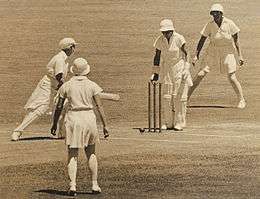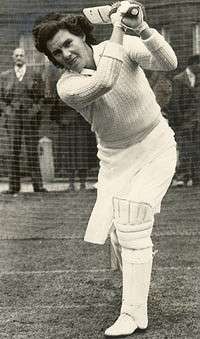Women's Test cricket
Women's Test cricket (WTest) is the longest format of women's cricket and is the female equivalent to men's Test cricket. Matches comprise four-innings and are held over a maximum of four days between two of the leading cricketing nations. The rules governing the format differ little from those for the men's game, with differences generally being technicalities surrounding umpiring and field size. Far fewer Women's Test matches are played each year in favour of Women's One Day Internationals and Women's Twenty20 Internationals, with the international calendar revolving around the shorter formats of the game. The first women's Test match was played by England women and Australia women in December 1934, a three-day contest held in Brisbane which England won by nine wickets.[1]

.jpg)
Playing conditions
Women's Test cricket is subject to the Laws of cricket, with a number of variations and refinements, which are set out in the ICC's "Women's Test match playing conditions" document. For the most part, these playing conditions are very similar to those set out for men's Test cricket. Matches are played between two teams of eleven players, across up to four innings. Test cricket can have three results: a tie, a draw, or one team wins.[2]
The primary, and most noticeable, difference from the men's game is that women's Test matches are played over four days, rather than five. However, the players are expected to fit more overs in per hour in the women's game than the men's: 17 as opposed to 15, and so a full day's play in a women's Test match should include 100 overs, rather than 90. The cricket field has smaller dimensions; the boundaries must be between 55 and 70 yards (50.29 and 64.01 m), in contrast to the 65 to 90 yards (59.44 to 82.30 m) required in men's Tests.[2][3] As well as playing on a smaller field, the women use a smaller and lighter ball than their male counterparts; the Laws of cricket dictate that women should use a ball that is between 4 15⁄16 and 5 5⁄16 ounces (139.98 and 150.61 grams); which could be up to 13⁄16 ounces (23.03 grams) lighter than the ball used by the men.[4] The Umpire Decision Review System (UDRS) is not available in women's Test matches, though umpires are permitted to ask the third umpire to check television replays in certain cases.[2][3]
Nations
In all, ten national women's teams have competed in Test cricket. The England team's tour of Australia and New Zealand in the 1934–35 season established the first three sides, and it is those three teams that have competed in Test cricket most frequently; each having played at least 45 matches. South Africa were the next side to play the format, contesting their first match in 1960.[5] However, due in part to their exclusion from international sport due to the nation's apartheid policy,[6] they have only played in eleven Test matches, less than both India and the West Indies. Four sides — Pakistan, Ireland, the Netherlands and Sri Lanka — have all competed in fewer than five Test matches.[5]
As of April 2019, there had only been one Women's Test match in the last three years, and only two teams other than England and Australia had played in a Women's Test in the previous ten years.[7] Australia's captain, Meg Lanning, expressed her interest in more Women's Test matches being played.[8] In July 2019, following the conclusion of the one-off Women's Ashes Test in England, the question was raised about whether Women's Test matches should be played across five days, instead of four. The match had two sessions washed out and finished in a draw.[9] In December 2019, New Zealand's Sophie Devine requested that administrators should arrange a Women's Test match between New Zealand and Australia, following a strong performance in the Women's Big Bash League.[10] New Zealand's women last played in a Test match in 2004, and their last encounter against Australia in the format was in 1996.[11] In June 2020, during an ICC webinar, Devine and India's Jemimah Rodrigues both supported the idea of a multi-format series for women's cricket.[12]
| Team | First | Latest | Matches |
|---|---|---|---|
| 1934 | 2019 | 74 | |
| 1934 | 2019 | 95 | |
| 1976 | 2014 | 36 | |
| 2000 | 2000 | 1 | |
| 2007 | 2007 | 1 | |
| 1935 | 2004 | 45 | |
| 1998 | 2004 | 3 | |
| 1960 | 2014 | 12 | |
| 1998 | 1998 | 1 | |
| 1976 | 2004 | 12 |
Records

Due to the infrequent playing of women's Test cricket outside of Australia, England and New Zealand, cumulative records, such as the most runs during a career, are dominated by players from those three nations. England's Jan Brittin has scored the most runs during her career, totalling 1,935 during her 27 matches, and 18 of the top twenty players come from either Australia, England or New Zealand.[13] The Australian batsman Denise Annetts, who is 15th on that list,[13] has the highest batting average, 81.90, from her ten matches.[14] Annetts was also involved in the largest partnership in women's Test cricket, sharing a stand of 309 runs with Lindsay Reeler in 1987.[15] Seven women have scored double centuries in Test cricket; the highest of these was the 242 runs scored by Pakistan's Kiran Baluch against the West Indies in 2004.[16]
Mary Duggan, who played for England between 1949 and 1963 is the leading wicket-taker in women's Test cricket, claiming 77 wickets from 17 matches.[17] The next most prolific bowler is Australia's Betty Wilson, who claimed her 68 wickets at the lowest bowling average, 11.80 and the first hat-trick in Women's Test cricket.[18] Both of the players with the best bowling figures, in an innings and in a match, are from the Indian subcontinent; India's Neetu David holds the record for the best figures in an innings, having taken eight second innings wickets against England in 1995,[19] while Pakistan's Shaiza Khan took thirteen wickets in a match against the West Indies in 2004.[20]
Amongst wicket-keepers, Christina Matthews has taken the most dismissals in her career, accumulating 46 catches and 12 stumpings during her 20 matches for Australia.[21] Lisa Nye holds the record for the most dismissals in a single innings, having been responsible for eight of the ten wickets for England against New Zealand in 1992.[22] Only two players have achieved the all-rounders double of scoring a century and taking ten wickets in the same match; Betty Wilson did it against England in 1958, while Enid Bakewell managed it for England against the West Indies in 1979.[23] Wilson's performance was the first time such a feat had been achieved in Men's or Women's Tests and also included the first hat-trick in Women's Tests.[24]
See also
- List of women's Test cricket grounds
- The Women's Ashes
- Women's One Day International cricket
- Women's Twenty20 International
References
- "1st Test: Australia Women v England Women at Brisbane, Dec 28–31, 1934". Cricinfo. 28 December 1934. Retrieved 9 February 2010.
- "Women's Test match playing conditions" (PDF). International Cricket Council. 1 October 2012. Retrieved 12 May 2013.
- "Standard Test match playing conditions" (PDF). International Cricket Council. 30 April 2013. Retrieved 12 May 2013.
- "Law 5 (The ball)". Marylebone Cricket Club. Retrieved 12 May 2013.
- "Records / Women's Test matches / Team records / Results summary". ESPNcricinfo. Retrieved 1 January 2015.
- "From the Archive: Gleneagles Agreement on Sport". Commonwealth Secretariat. 11 June 2009. Archived from the original on 17 September 2012. Retrieved 12 May 2013.
- "India the key to more women's Tests - Lanning". ESPN Cricinfo. Retrieved 9 April 2019.
- "Meg Lanning wants a more steady diet of Test cricket". International Cricket Council. Retrieved 9 April 2019.
- "Should women's Tests be played over five days?". ESPN Cricinfo. Retrieved 23 July 2019.
- "Sophie Devine pleads for White Ferns to be scheduled a test match". Stuff. Retrieved 4 December 2019.
- "NZ want Test off WBBL success". The Australian. Retrieved 4 December 2019.
- "Sophie Devine backs smaller, lighter ball in women's cricket". ESPN Cricinfo. Retrieved 10 June 2020.
- "Records / Women's Test matches / Batting records / Most runs in career". ESPNcricinfo. Retrieved 12 May 2013.
- "Records / Women's Test matches / Batting records / Highest career batting average". ESPNcricinfo. Retrieved 12 May 2013.
- "Records / Women's Test matches / Partnership records / Highest partnerships for any wicket". ESPNcricinfo. Retrieved 12 May 2013.
- "Records / Women's Test matches / Batting records / Most runs in an innings". ESPNcricinfo. Retrieved 12 May 2013.
- "Records / Women's Test matches / Bowling records / Most wickets in career". ESPNcricinfo. Retrieved 12 May 2013.
- "Records / Women's Test matches / Bowling records / Best career bowling average". ESPNcricinfo. Retrieved 12 May 2013.
- "Records / Women's Test matches / Bowling records / Best figures in an innings". ESPNcricinfo. Retrieved 12 May 2013.
- "Records / Women's Test matches / Bowling records / Best figures in a match". ESPNcricinfo. Retrieved 12 May 2013.
- "Records / Women's Test matches / Wicketkeeping records / Most dismissals in career". ESPNcricinfo. Retrieved 12 May 2013.
- "Records / Women's Test matches / Wicketkeeping records / Most dismissals in an innings". ESPNcricinfo. Retrieved 12 May 2013.
- "Records / Women's Test matches / All-round records / 100 runs and 10 wickets in a match". ESPNcricinfo. Retrieved 12 May 2013.
- "Records / Women's Test matches / Bowling records / Hat-tricks". ESPNcricinfo. Retrieved 21 April 2014.